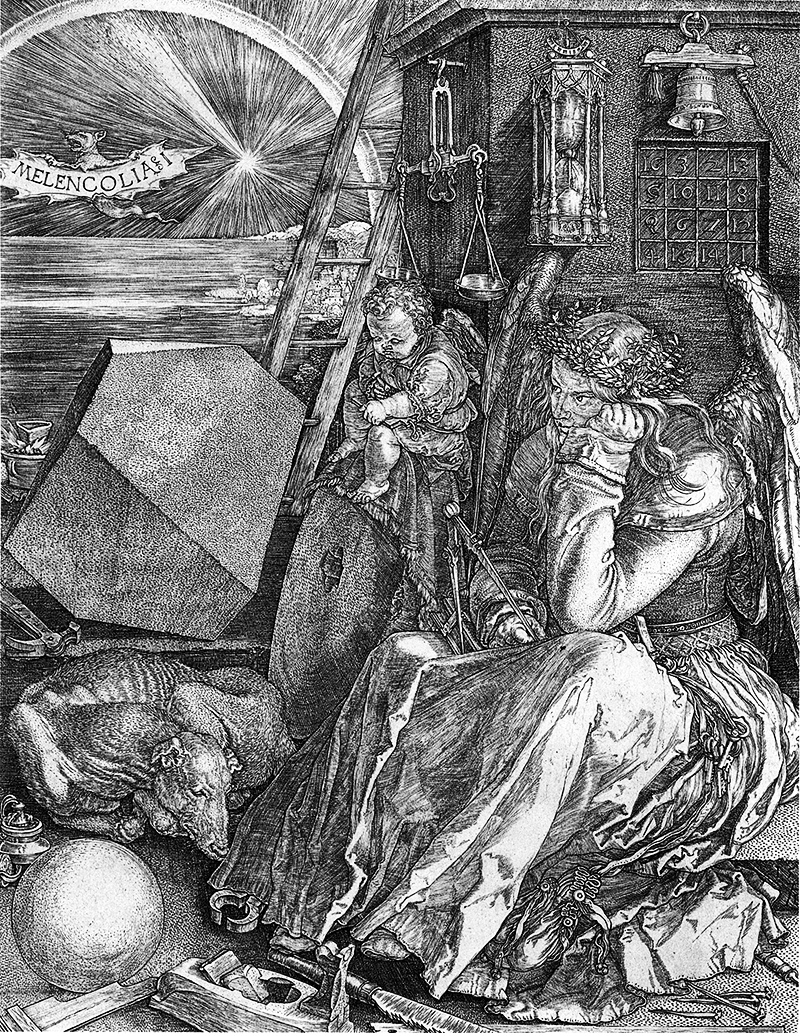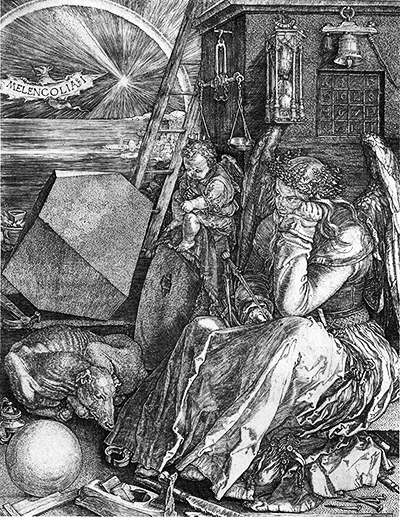Melencolia I was an engraving by skilled German artist Albrecht Durer who himself excelled in many different art mediums
Durer was a leading light in the Northern Renaissance where artists from Germany and the Netherlands went about competing with the Italian Renaissance spearheads with their own impressive levels of innovation within the mainstream arts. Many of the art mediums and techniques in which Albrecht Durer was involved were not part of the accepted art mainstream at that time, but he helped to promote them as worthwhile and of value to the academics. The likes of watercolours and landscape painting all benefited from their exposure within Durer's career. You can find more Durer prints here. Melencolia I is in the opinion of some writers to actually be a inward reflection of the mind of artist Durer, though this is just one of the huge number of differing views that have been expressed in recent years about Durer's classic engraving which has gone on to become one of the most studied and respected engraving prints of all time. It is exceptionally impressive to see an artist who made his name as far back as the 15th and 16th centuries to still have such a well remembered career.
Durer's engraving came in 1514 and measures 31cm by 26cm. Durer was comfortable within his native Nuremburg and saw little reason to journey around other cities or countries to pursue his artistic development. This contrasts greatily with many artists who are curious enough to travel to all parts in the pursuit of developing their own skills, be it to other parts of their own country or even to other continents. There are further Durer paintings here. Melancholia I has been the subject of an incredible level of discussion and analysis for generations, with many seemingly finding all sorts of symbolism within this engraving that others might not have seen at first glance, or indeed even agree with. Academics have always flocked to the career of Durer and Melancholia I has been there main focus since Durer created it way back in 1514 at a time when European art was in the early stages of developing towards the many different art movements which we enjoy today.
The generally accepted belief is that this engraving print simply reflects the state of melancholy, and that each different object within the art work, including the female portrait, are to depict this depressive state in different forms. Many elements within the work have an obvious level of sadness, making this explanation most likely. As with all artists of this time, there is a distinct lack of supportive evidence to back up any claim and as such this controversy to likely to continue without any conclusion being found.
Praying Hands is an emotional painting by Albrecht Durer and represents an important gesture towards his brother, with the two forging a very close relationship when they were younger and both struggling with the difficult upbringing that they experienced as part of a large family. They would help each other to become trained artists without any financial backing. The Praying Hands refer to Albrecht's brother, Albert, who would give so much towards his brother's success as an artist.
Praying Hands is amongst the best known paintings by Durer but few in the modern era probably realise the emotional link to his family and Albrecht's relatively poor unbringing. The title and clear imagery seem to have been enough for it to live on strongly and for perhaps new meanings to be attached by those who see other meanings in it that perhaps were not originally given to the painting by Albrecht Durer.

Young Hare is a popular painting by Durer with many adding it to their own homes as a print reproduction. Small animals such as Hares are always going to sell well in the current market with so many animal lovers around, but this painting is impressive in it's own right and goes fa beyond just depicting a cute animal. Young Hare came in watercolour and bodycolour which is an exceptionally unusual set of mixed media today, but was reasonably common back in 1502 when Durer created this art work.
List of Albrecht Durer Paintings
Albrecht Durer produced many great works besides just Melancholia I and the other paintings featured in this homepage, with further key paintings, sketches and etchings from his career being featured below.
- The Little Owl
- The Four Horsemen Of The Apocalypse
- The Knight Death And The Devil
- Melancholy I
- Praying Hands
- Self Portrait
- Wing of a Roller
- Self Portrait At 26
- Durer's Mother
- Nativity
- Great Piece of Turf
- Young Hare
- St Michaels Fight Against The Dragon
- Self-Portrait II
- Witch Riding Backwards On A Goat
- Adam and Eve (The Fall of Man)
- Feet Of A Kneeling Man
- Apollo And Diana
- Adoration of the Trinity
- Study Of Drapery
- Durer's Wife Agnes
- Martyrdom of the Ten Thousand
- View of Arco
- Hand
List of Nothern Renaissance Artists
Albrecht Durer is seen by many as the leading member of the Northern Renaissance which is an exceptional achievment considering the other artists that are included within it and the legacy that each of them left. See below for a full list of famous painters within the Northern Renaissance.
Famous Dutch Northern Renaissance Painters
- Jean Bellegambe
- Hieronymus Bosch
- Dirk Bouts
- Robert Campin
- Petrus Christus
- Jacques Daret
- Gerard David
- Hubert van Eyck
- Jan van Eyck
- Geertgen tot Sint Jans
- Hugo van der Goes
- Adriaen Isenbrant
- Limbourg brothers
- Quentin Matsys
- Hans Memling
- Joachim Patinir
- Roger van der Weyden
Famous German Northern Renaissance Painters
- Hans Baldung
- Lucas Cranach the Elder
- Lucas Cranach the Younger
- Albrecht Dürer
- Matthias Grünewald
- Hans Holbein the Elder
- Hans Holbein the Younger
- Ambrosius Holbein




